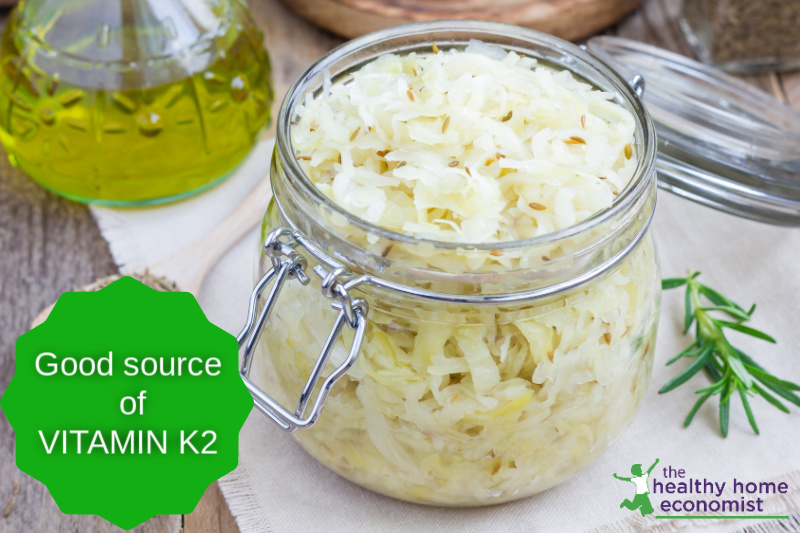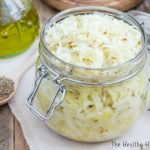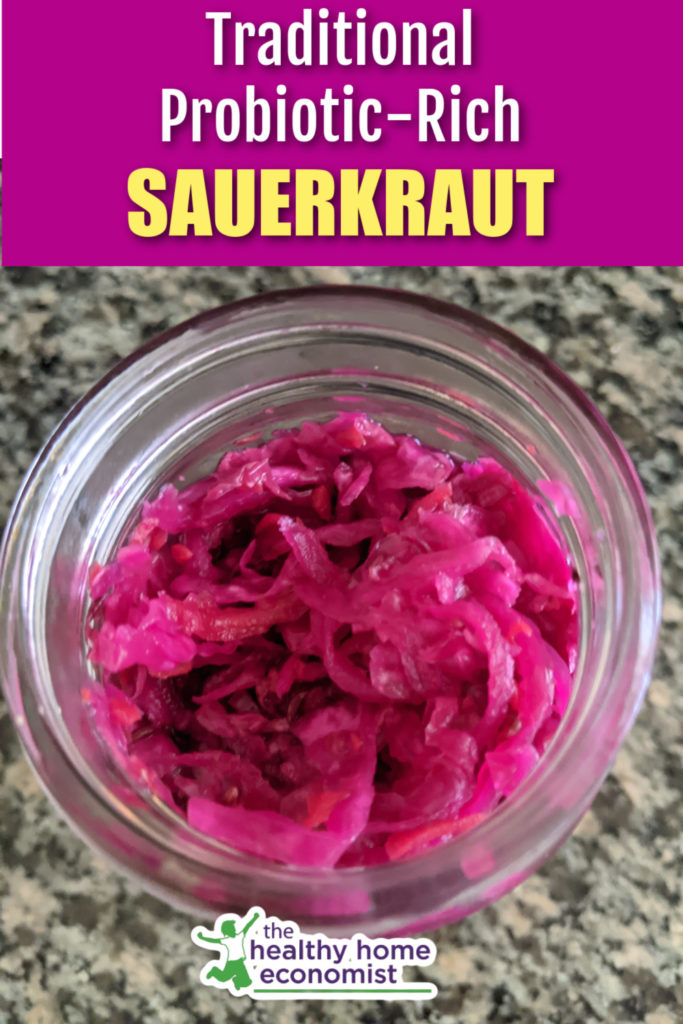Recipe and detailed video instruction on how to make traditional sauerkraut that is loaded with probiotics and Vitamin K2 for better digestion and health. 
By popular demand, the process of making homemade sauerkraut is explained and demonstrated in the two video lessons below. The written recipe is also provided by those who wish to dive right in.
This traditional food is probiotic-rich and very nutrient-dense unlike the vinegar-packed sauerkraut wanna-be’s at the store.
The first video covers a brief history of sauerkraut and what you need on hand to make it. The second video covers how to make sauerkraut yourself quickly and easily in your kitchen.
The sauerkraut recipe I use is based on the Nourishing Traditions method.
Benefits of Fermenting Cabbage
Eat small amounts of this probiotic-rich condiment with cooked foods to improve digestion and assimilation.
Remember that fermenting does not reduce the goitrogens (thyroid suppressing substances) in the cabbage. So, if you have thyroid issues, you may wish to consider avoiding this particular condiment.
If your thyroid status is good and you eat plenty of iodine-rich foods like grassfed butter, then sauerkraut is a healthy addition to the diet.
Loaded with Vitamin K2
Did you know that properly cultured cabbage contains a significant amount of natural Vitamin K2? This is an elusive nutrient that is very hard to get in the diet. It is essential for strong bones and healthy teeth.
The USDA reports that one cup of sauerkraut contains 81 mcg. No doubt this is the commercial, pasteurized stuff that the USDA is testing too.
I would venture to suggest that making raw sauerkraut yourself and fermenting properly would potentially contain larger amounts.
Natural Remedy for Reflux
Another bonus of eating raw fermented cabbage is that it is a natural way to prevent acid reflux. Simply eat a mouthful or two a few minutes before the start of a meal.
Want to experience these benefits for yourself? Two detailed video lessons are included with the recipe below.
Tip: Be sure to wear an apron when you make this dish as you will see in the video! ?
Why don’t you try it today! You will never go back to the pasteurized, shelf stable sauerkraut at the store!

Homemade Sauerkraut Recipe
Basic recipe for homemade sauerkraut as traditionally made as a live cultured food loaded with probiotics and enzymes to aid digestion and absorption of nutrients.
Ingredients
- 1 green or purple cabbage medium size, preferably organic
- 4 Tbl liquid whey
- 1 Tbl caraway seeds
- 1 Tbl sea salt
Instructions
-
Core and chop cabbage. Place all the chopped cabbage and other ingredients together in a large sturdy bowl.
-
Pound the juices out of the cabbage thoroughly with a kitchen pounder of some kind for a full 10 minutes.
-
Tightly pack the cabbage into a one quart mason jar leaving at least 1 inch of space at the top. Tightly seal with the lid.
-
Leave on the counter for 3 days and then refrigerate.
-
The flavor of the homemade sauerkraut improves over time. It will last many months in your refrigerator or cool cellar.
Recipe Video

References
(1) Vitamin K2 in Sauerkraut
(2) Nourishing Traditions
More Fermented Food Recipes
Love this sauerkraut recipe? Try these other delicious fermented foods and drinks below and unleash the power of a traditional diet in your home.
How to Make Fermented Lemonade
How to Make Orangina
Mango Chutney Recipe
Homemade Apricot Butter
Fermented Potatoes
Probiotic Corn Relish
How to Make Fermented Cilantro Salsa
Beet Kvass Recipe








Hi i am Lactose intolerant and can’t have Whey is there anything else i can use instead? To get the same result when using Whey?
Regards
Hi, thank you for being so generous and sharing precise information about several topics. I am interested in fermented vegetables. You recommend the use of whey, I understand it is obtained from milk. Since we are allergic to dairy, what would you recommend? Thank you
I would suggest a vegetable starter like this one: http://amzn.to/1Rbo0gQ
My saurerkraut is turning brown on the top portion. Is it safe to eat and can I salvage it?
I am anxious to try making the sauerkraut but when I put the yogurt in the cheesecloth it poured right through it. I bought another brand and it did the same. Is there a certain brand of cheesecloth I need to buy? Seems that the weave on the ones I have is to open. Please advise. Thanks
Gina, this is quite old, and you may have figured out how to effectively strain yogurt by now. What I do is place a sieve over a bowl and put a regular paper coffee filter into the sieve. Pour the yogurt into the coffee filter, but careful not to overfill. You’ll see the whey drip nicely out the bottom, into the bowl. When the yogurt is strained, it easily comes peels out of the filter and you’re left with a nice Greek-style yogurt.
Hi Sarah,
Can I use the liquid whey from the kefir that I am making with organic whole milk to ferment the sauerkraut? If I can how do I take the whey out after making the kefir?. I am guessing I just strain out the light yellowish liquid from the kefir.
Firstly, may we have your recipe for Kimchi?
Secondly, can you add other vegetables like carrots to make Kraut.
Thirdly, can you successfully use whey produced by straining home made yoghurt? I use fresh full cream, pasteurised but not homogenised Jersey milk and a Bulgarian starter.
Thanks
Cris, raw milk is not legal in Louisiana either so I purchase my 100% grass-fed whey, called SueroGold, from a company called Beyond Organic. It is low temperature pasteurized and it has worked really well for all of my ferments. I actually drink a bottle of the flavored whey everyday. Here is the web site for more information:
It appears that one needs unpasteurized milk to make liquid whey. hmmm. I have no access to unpasteurized milk. Any advice? thanks. BTW. I love your blog. Great videos.
Thank you Sarah,
Is the shape of clear glass jar important? in fermentation in general?
i have wide and short jar shape…I mean does the fermentation need only certain area of space of air or one inch of space at the top is perfect ….and 10 inches air space doesn’t matter..??
i know the air surface matter in clabering milk like you explained in video.
i like to make the ketchup and don’t have the same jar shape, please help